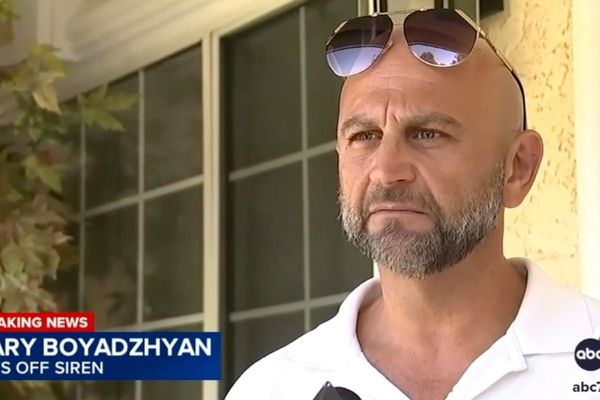Three new cancer drugs could help AstraZeneca make a dent in its lofty ambition to become an $80 billion company by 2030, an executive told Investor's Business Daily.
On Sunday and Monday, AstraZeneca unveiled the results of three studies in patients with forms of breast and gastric cancer. If approved, the regimens would treat an estimated 82,000 patients across Canada, France, Germany, Italy, Japan, the U.K. and the U.S. each year, Dave Fredrickson, executive vice president of AstraZeneca's oncology business unit, said in an interview.
And Fredrickson expects those approvals to come soon, potentially in less than a year.
"We are unlocking multibillion-dollar blockbuster opportunities in 2025 across the portfolio," he said. "I think it puts us in a very strong position for oncology to make a very meaningful contribution to our $80 billion growth ambition that we've put forth."
AstraZeneca Targets 40,000 Patients
The biggest opportunity stems from the Matterhorn study, which tested Imfinzi in patients with a form of stomach and esophageal cancer.
Typically, patients with gastric or gastroesophageal cancer first undergo a five-drug chemo regimen to shrink the tumors prior to surgery. But this cancer has a high recurrence rate. One in four will develop new tumors within a year of surgery. So, AstraZeneca tested following up the two-punch approach of chemo and surgery, by adding an Imfinzi knockout.
The result?
Patients had a 29% lower risk of their cancer returning.
"The goal that many, many care teams have with their patients is to drive towards long-term elimination of recurrence because that actually is a drive toward cure," AstraZeneca's Fredrickson said. "So, being able to improve by nearly 30% the risk of recurrence is a very important outcome for patients in this setting."
He estimates that 40,000 patients in the G7 countries could benefit from this new use for Imfinzi.
Imfinzi is already a massive moneymaker for AstraZeneca. It's an immuno-oncology drug that helps the immune system find tumor cells camouflaging themselves behind a common protein called PD-L1. In the first quarter, it generated $1.26 billion in sales, making it AstraZeneca's second-biggest cancer drug.
Can Enhertu Make Its Mark?
Investors are also closely watching Enhertu, which AstraZeneca developed with Daiichi Sankyo, as a potential replacement for chemo in some regimens.
Enhertu belongs to the high-profile antibody drug conjugate, or ADC, drug class. These drugs are like smart bombs for cancer. They send toxic chemicals directly to targets on cancer cells. This limits their damage to nearby healthy tissue — a common problem with chemotherapy.
In the Destiny Breast-09 study, AstraZeneca tested Enhertu plus Perjeta in patients with an advanced form of breast cancer. Perjeta is a common breast cancer treatment. Researchers compared the combo to a regimen using Roche's Herceptin, Perjeta and chemotherapy. This is a 32,000-patient opportunity in the G7 countries, according to AstraZeneca's Fredrickson.
Patients had never before been treated for their breast cancer. This is important because Enhertu is currently approved for breast cancer patients who've already undergone — and worsened — on an earlier treatment. In the study, Enhertu patients lived for 40.7 months before their cancer progressed. That compares to 26.9 months for those who received standard drugs.
The results suggest moving Enhertu earlier in the treatment paradigm could benefit patients.
"Too many patients don't actually get an opportunity to get subsequent lines of therapy," Fredrickson said. "And so Destiny Breast-09 says that for the nearly one-third of patients who don't ever make it to a second-line therapy that they've got an opportunity to be able to benefit from an Enhertu-based regimen."
Blood Tests To Inform Treatment Plans
The final opportunity is in an estimated 10,000 patients with another form of breast cancer. Generally, these patients will receive what's known as an aromatase inhibitor and a drug that blocks CDK4 and 6. These play a vital role in cell cycle progression, which cancer cells use to spread.
But a third of these patients will develop a mutation in their ESR1 gene. This allows the cancer to evade treatment.
Patients underwent blood tests every three months to determine whether and when the mutation took place. This allowed AstraZeneca to "get in front of the cancer" by switching to an experimental drug AstraZeneca calls camizestrant. Camizestrant has shown promise in patients with ESR1 mutations.
"It's a strategy to outsmart the cancer," he said.
The bet paid off. Patients who were detected to have the mutation and switched to camizestrant had a 56% reduction in the risk of their cancer worsening.
"I think these are incredibly exciting studies and that's why they're plenaries at this year's ASCO," he said, referencing the American Society of Clinical Oncology annual meeting in Chicago.
AstraZeneca Is Underperforming Its Group
These three drugs play into several megatrends AstraZeneca is exploring in cancer treatment.
Fredrickson points to new modalities like ADCs and new means of harnessing the immune system to defeat cancer as helping drive the oncology space forward. The company is also looking at combinations and earlier intervention to drive better patient outcomes.
"AstraZeneca is really at the vanguard of those trends and advancing science in a meaningful way," he said.
Shares of the pharma giant, though, have recently underperformed the industry group.
AstraZeneca stock has a Relative Strength Rating of 34, according to IBD Digital. This means shares rank near the bottom one-third of all stocks when it comes to 12-month performance. That has declined from 76 three months ago. The Medical-Diversified industry group has a higher RS Rating of 57, which has improved from 31 three months ago.
AstraZeneca shares are forming a lengthy consolidation with a buy point at 87.67, but remain below their 200-day moving average, MarketSurge shows.
Follow Allison Gatlin on X/Twitter at @AGatlin_IBD.







